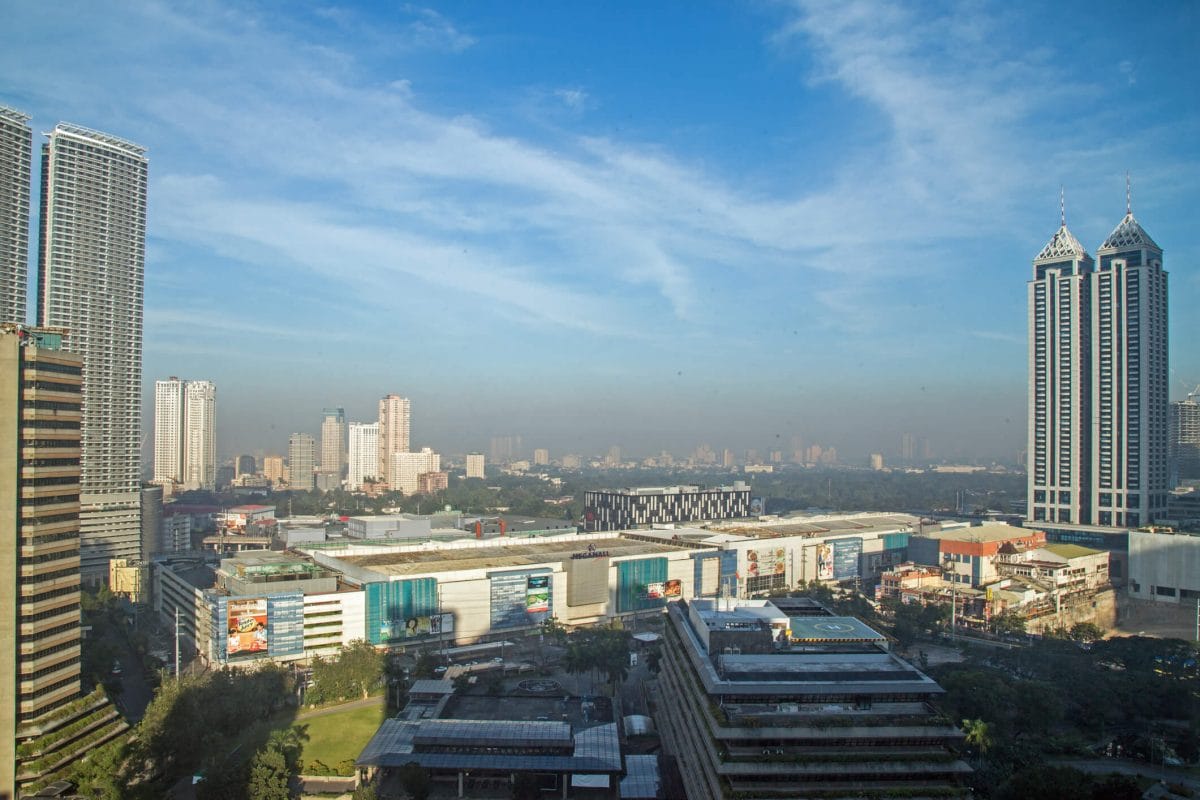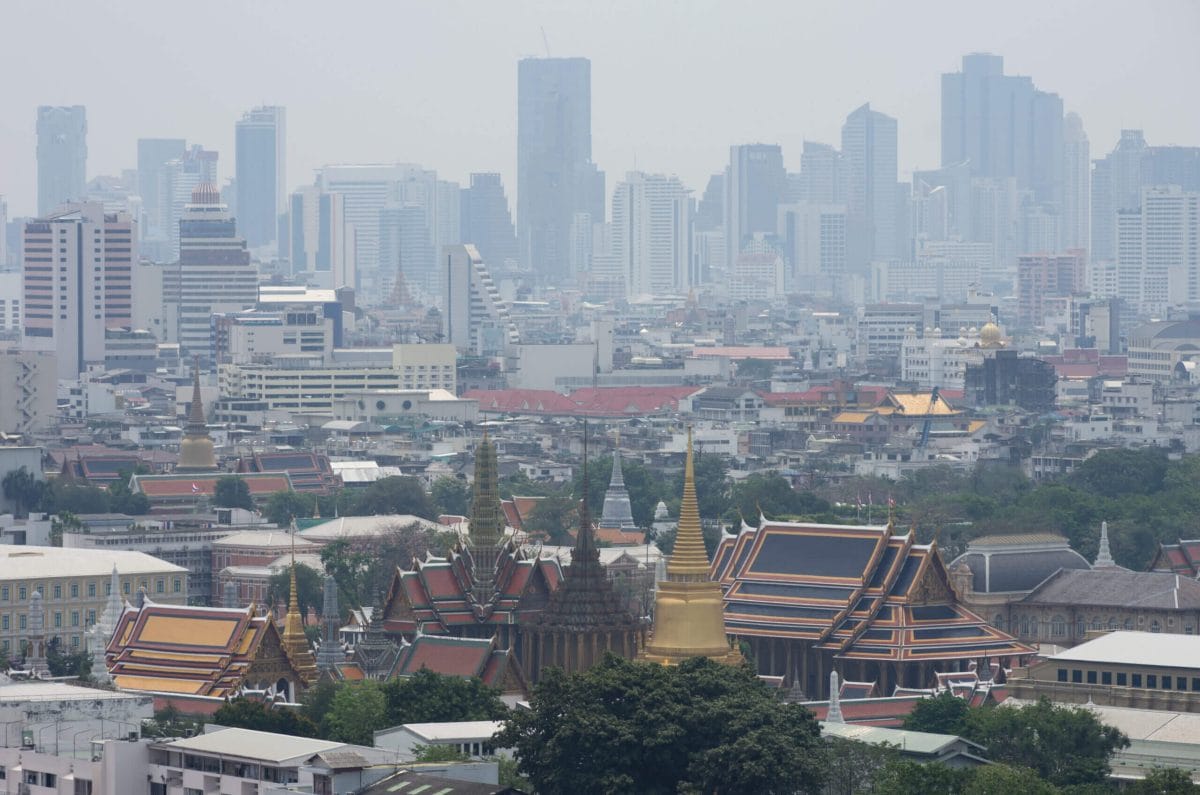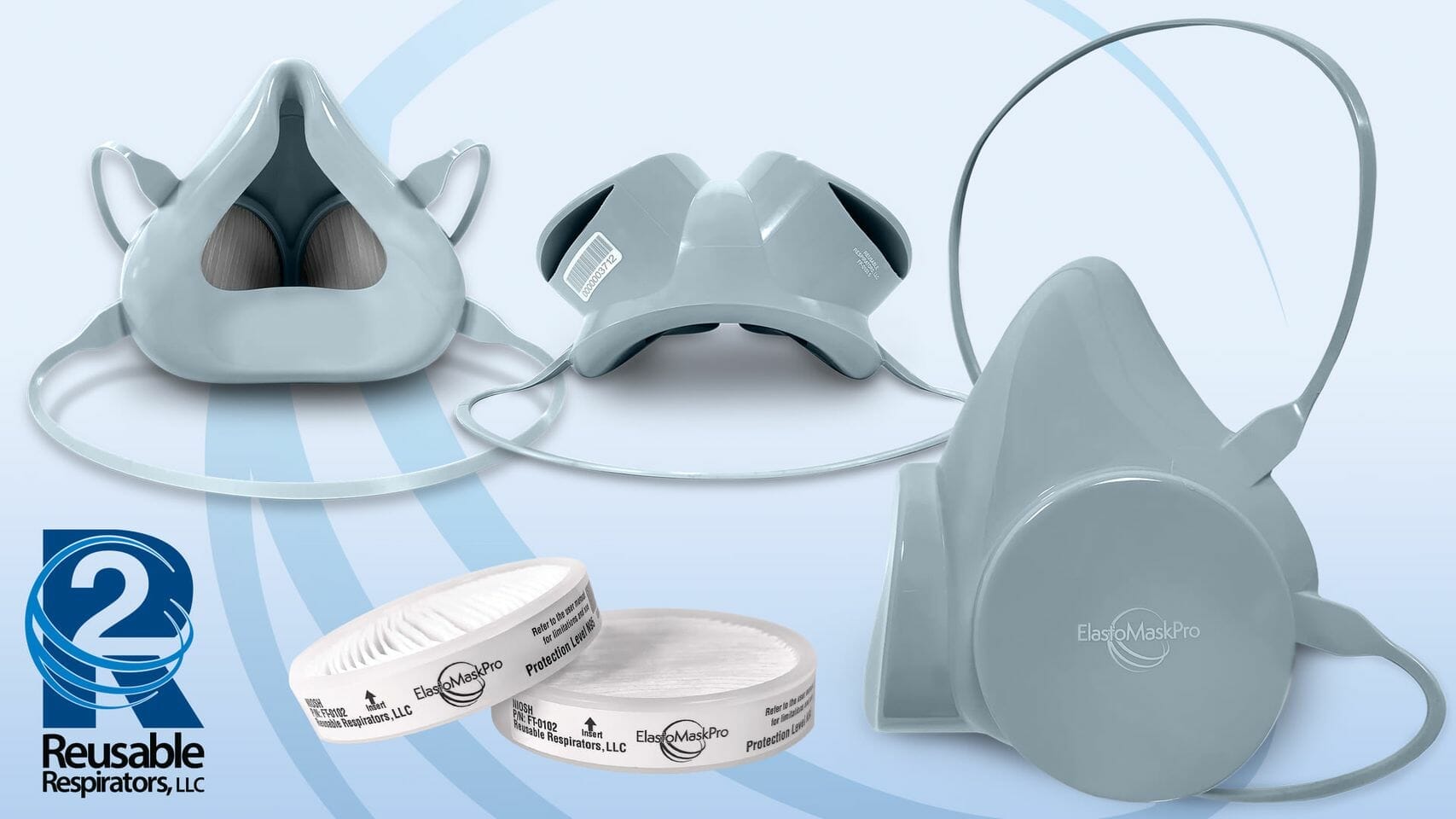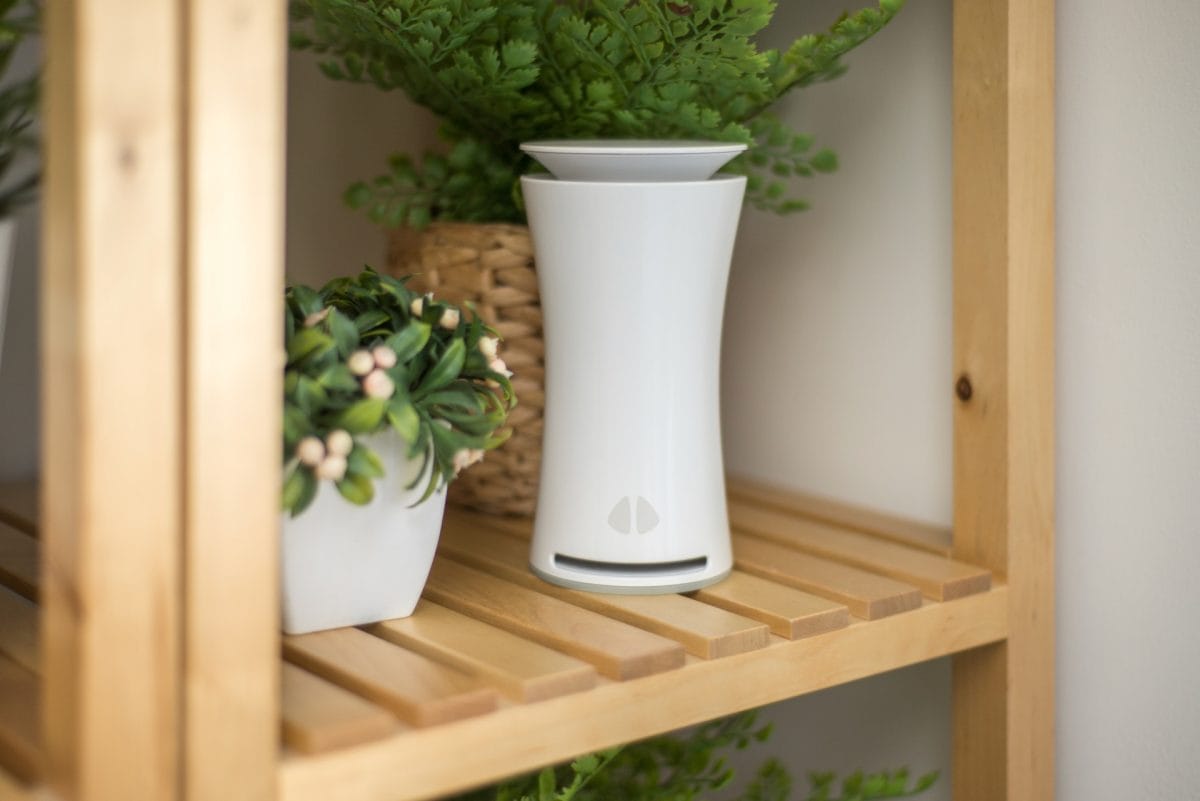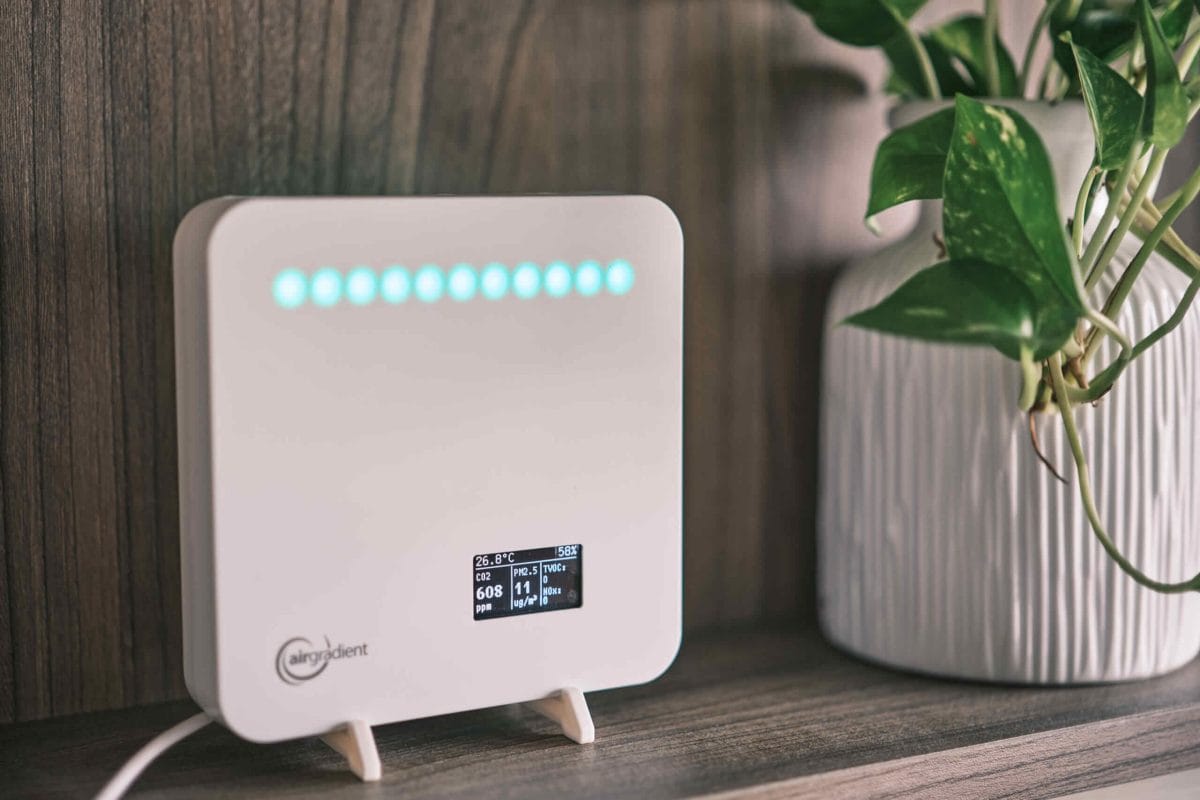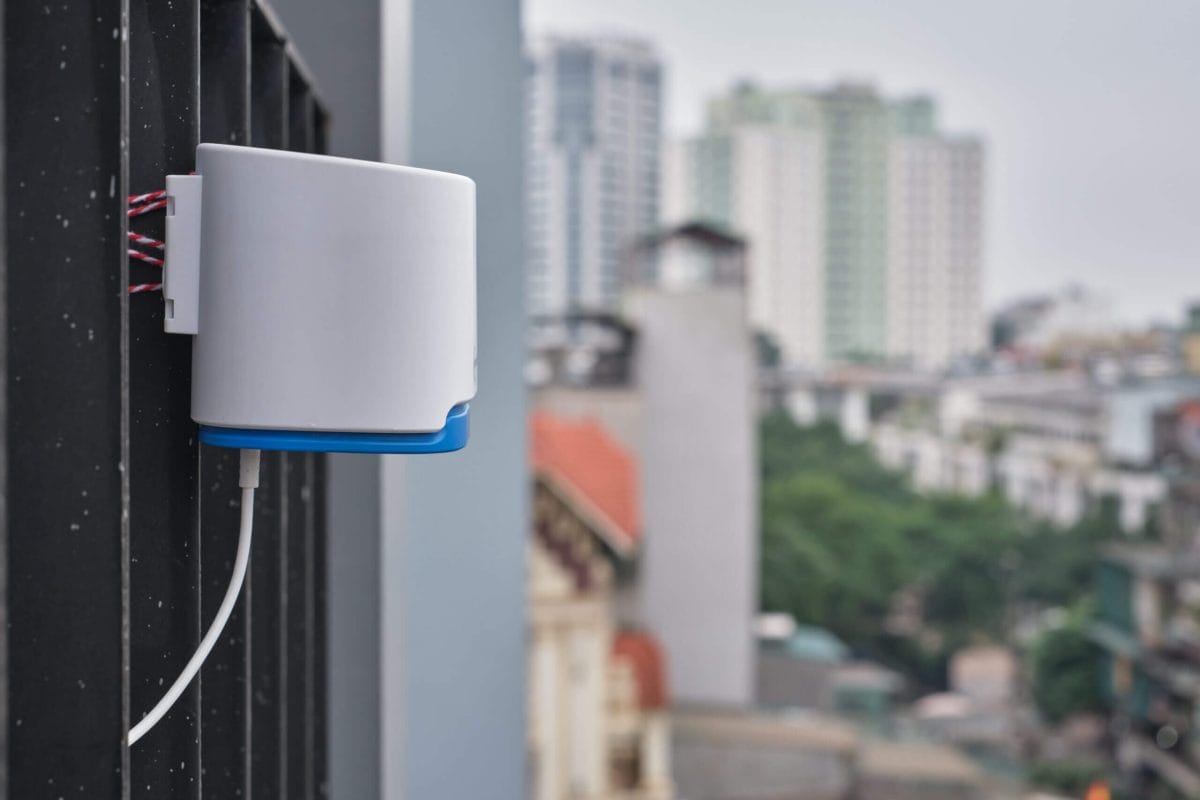Vietnam’s air pollution issue is a silent yet daunting challenge that lurks beneath its cultural vibrancy and scenic beauty. While the global environmental discourse often overlooks Vietnam, the air quality in its bustling cities, such as Ho Chi Minh and Hanoi, starkly contrasts the country’s picturesque landscapes, underscoring a growing environmental crisis. During my stays in Ho Chi Minh, Hanoi, Nha Trang, and Da Nang, I’ve experienced this first-hand, living through the haze of pollution that blankets these cities – especially Ho Chi Minh – for almost a year.
The numbers are telling. According to the World Air Quality Report, Ho Chi Minh City and Hanoi frequently feature among the world’s most polluted cities. In 2021, Hanoi’s Air Quality Index (AQI) regularly exceeded the ‘unhealthy’ threshold, reflecting a broader issue that plagues urban areas across Vietnam. This isn’t just a statistic but a daily reality for millions who navigate life amidst these challenging conditions.

Although Vietnamese cities are rarely polluted enough to make headlines, HCMC and Hanoi almost always exceed WHO air quality guidelines – sometimes greatly.
Interestingly, the public discourse around air pollution varies significantly across Asia. In Seoul, where I previously resided, the conversation about air quality was regular, a weekly or monthly topic amongst locals and expatriates alike. Similarly, during my time in Thailand, the air pollution issue was a frequent point of discussion, reflecting widespread awareness and concern.
Even before I visited India, its major cities’ notorious air quality issues were well-known. In stark contrast, throughout my stay in Vietnam, the topic of air pollution was notably absent from conversations. Considering the severity of the problem, this silence is intriguing and highlights a critical gap in public awareness and dialogue.
The issue of air pollution in Vietnam often escapes global attention. It’s a silent epidemic, affecting the health and well-being of its citizens and the many visitors who come to experience its culture and natural beauty. The detrimental effects of such pollution are far-reaching, impacting not only the immediate health of individuals but also posing long-term environmental and economic challenges.
This article will delve deeper into the complex nature of air pollution in Vietnam. We’ll explore its causes, understand its seasonal shifts, and examine how geography plays a crucial role. Moreover, we’ll discuss the health implications for those living in these conditions and consider the efforts being made to combat this growing concern. I aim to shed light on this critical issue, hoping to bring it the attention and action it urgently requires.
Subscribe to BreatheSafeAir
Air pollution is a silent killer that affects millions of people worldwide. Start protecting yourself today.
This post contains affiliate links. For more information, please refer to my affiliate disclaimer.
Information on this blog is for informational purposes only. Readers are encouraged to confirm the information herein with other sources. Furthermore, this information is not intended to replace medical advice from professionals. This website assumes no responsibility for the accuracy of the information, which is subject to change without notice.
Is Air Pollution an Issue in Vietnam?
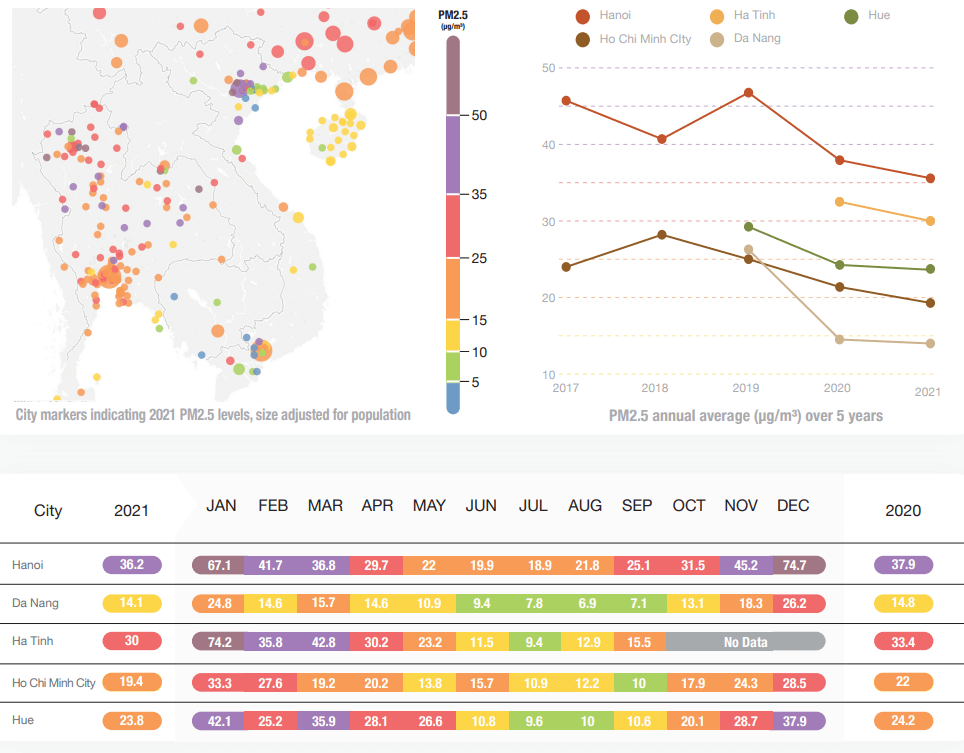
Air pollution in Vietnam is a significant and pressing issue that warrants a detailed examination. The country faces a growing air quality crisis due to rapid urbanisation and industrialisation, particularly in its major cities. This section aims to explore the depth of this issue, relying on statistics and reports, and to understand how Vietnam’s situation compares with its neighbours in Southeast Asia.
Vietnam’s major urban areas, notably Hanoi and Ho Chi Minh City, are at the forefront of the air pollution crisis. According to IQAir’s 2021 World Air Quality Report, these cities frequently rank among the most polluted globally. The report reveals startling figures: for instance, Hanoi’s Air Quality Index (AQI) consistently exceeded the ‘unhealthy’ threshold in 2021, indicating severe air quality issues (IQAir, 2021). The full report is accessible here: World Air Quality Report 2021.
The data is revealing when comparing air pollution in Vietnam to neighbouring countries. While nations like Thailand, the Philippines, and Malaysia also grapple with air quality challenges, Vietnam’s air pollution levels are often higher. This disparity highlights Vietnam’s unique struggle against air pollution despite sharing similar developmental trajectories with its regional counterparts.
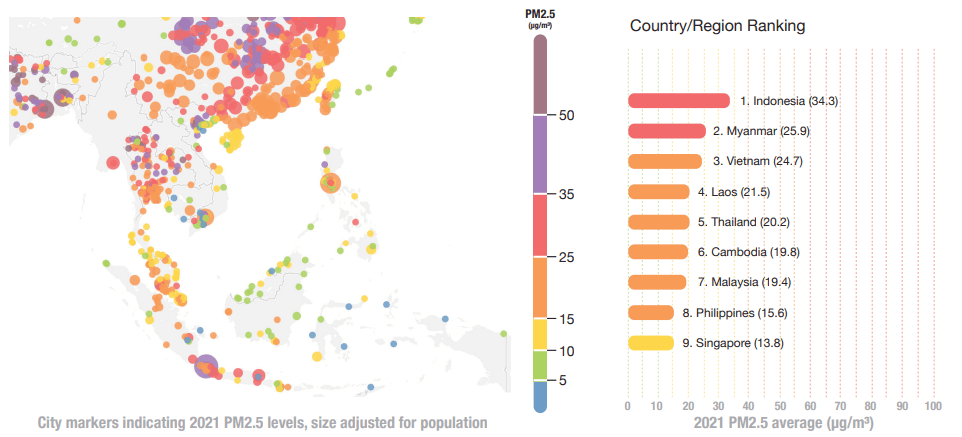
South-east Asia air pollution rankings. From the IQAir 2021 World Air Quality Report.
The health implications of air pollution in Vietnam are alarming. One study noted that air pollution contributes to thousands of premature deaths in Vietnam each year. Specifically, fine particulate matter, known as PM2.5, is a major concern. These tiny particles, prevalent in urban smog, can penetrate deep into the lungs and bloodstream, causing long-term health issues. Respiratory illnesses, cardiovascular diseases, and exacerbated asthma cases are just a few of the health conditions linked to prolonged exposure to polluted air.
To quantify the health burden, data from the Global Burden of Disease Study highlights that in Vietnam, there were approximately 60,000 deaths attributable to air pollution in 2019. This figure underlines the grave public health crisis stemming from deteriorating air quality. It’s not just a matter of discomfort or reduced visibility; it’s a matter of life and death for thousands each year.
Therefore, while air pollution in Vietnam may not always be at the forefront of public discourse, its impact is pervasive. The lack of visibility of this issue in everyday conversations and media coverage contrasts sharply with its severe health and environmental consequences. This silent crisis requires urgent attention and action, both at the policy level and public awareness.
In conclusion, the issue of air pollution in Vietnam is indeed profound and multifaceted. Its effects on health, combined with the statistical evidence of its severity, especially in urban areas, make it a critical environmental challenge. The comparison with Southeast Asian neighbours further underscores the need for targeted strategies to combat this growing menace. As we delve deeper into the causes and potential solutions in the following sections, it’s crucial to keep in mind the human cost of this ongoing crisis.
Why air pollution in Vietnam is a serious issue:
- Vietnam is experiencing a growing air quality crisis due to rapid urbanization and industrialization, especially in major cities like Hanoi and Ho Chi Minh City.
- IQAir’s 2021 World Air Quality Report shows that Hanoi and Ho Chi Minh City rank among the world’s most polluted, with Hanoi’s Air Quality Index frequently exceeding the ‘unhealthy’ threshold.
- Compared to neighbouring Southeast Asian countries, Vietnam faces higher air pollution levels despite similar developmental trajectories.
- Air pollution in Vietnam contributes to thousands of premature deaths annually, with fine particulate matter (PM2.5) causing severe long-term health issues.
- Despite its severe health and environmental consequences, the issue of air pollution in Vietnam often lacks visibility in public discourse and media coverage.
Causes of Air Pollution in Vietnam
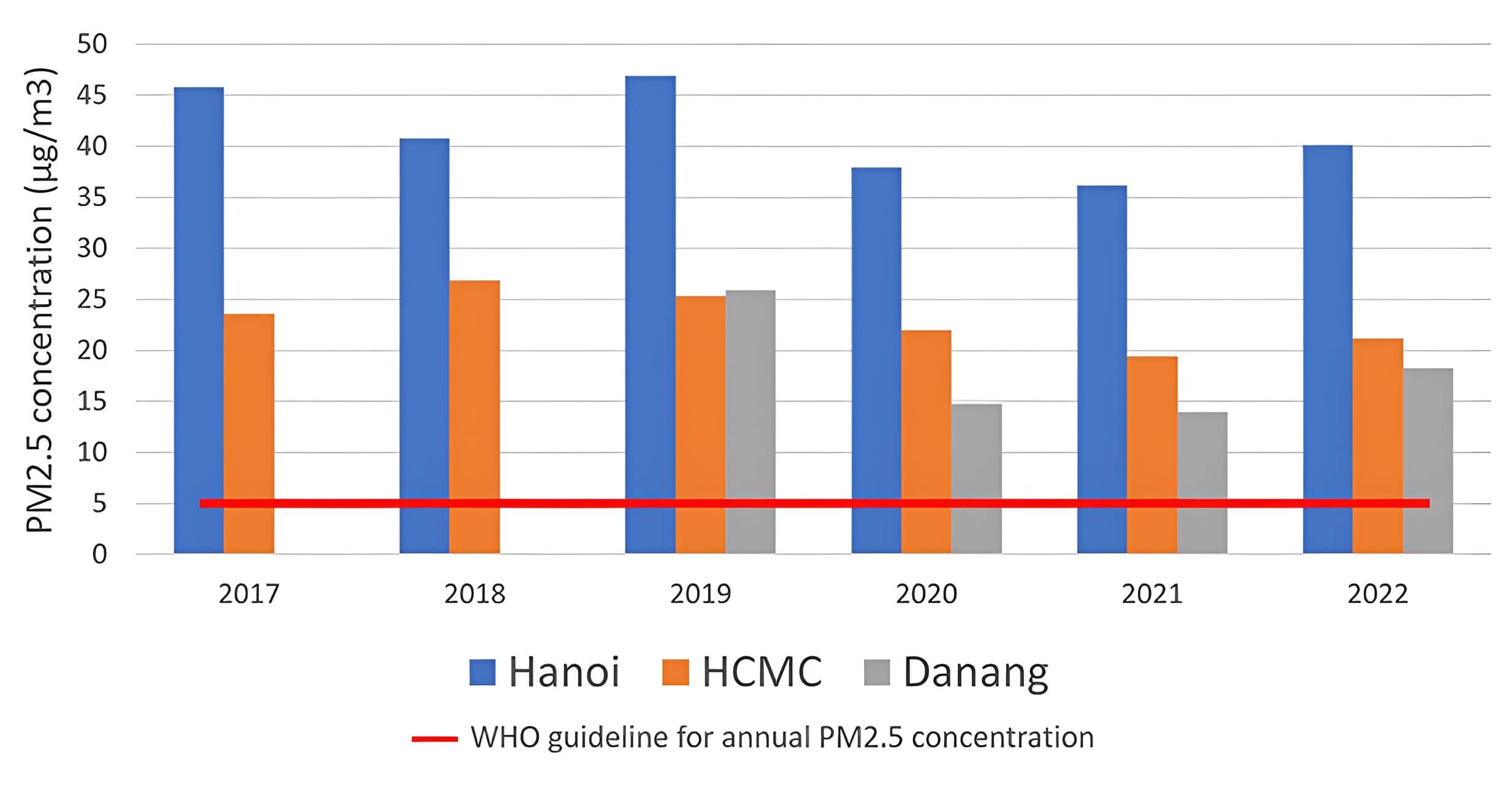
PM2.5 concentrations in major Vietnamese cities.
The issue of air pollution in Vietnam is complex and multifaceted, stemming from various domestic and transboundary sources. This section will explore these causes in detail to provide a comprehensive understanding of the factors contributing to the deteriorating air quality in Vietnam. First, let’s take a look at the primary domestic sources of air pollution in the country.
Domestic Sources of Air Pollution in Vietnam:
- Industrial Emissions: Factories, power plants, and processing units.
- Vehicular Pollution: Motorbikes, cars, and public transport vehicles.
- Agricultural Burning: Crop residue burning and deforestation.
- Construction Activities: Dust and particulate matter from construction sites.
- Household Pollution: Use of solid fuels for cooking and heating.
- Waste Burning: Open burning of waste in urban and rural areas.
It’s worth noting that while these sources impact all cities in Vietnam, the severity of each differs between cities. For example, Hanoi suffers from much worse air pollution due to agricultural burning. On the other hand, Ho Chi Minh City’s primary sources of pollutants are vehicular pollution and industrial emissions. Let’s break down these sources of pollution one by one.
One of the primary sources of air pollution in Vietnam is industrial emissions. As Vietnam’s economy has rapidly industrialized, the number of factories and industrial zones has increased significantly, particularly in and around major cities like Hanoi and Ho Chi Minh City. These industries, including manufacturing and processing units, often rely on fossil fuels and emit a considerable amount of pollutants, including particulate matter, sulfur dioxide, and nitrogen oxides. A study by the Vietnam Environment Administration highlights the significant role industrial emissions play in urban air pollution.
‘Gas emissions from vehicles, exhaust from factories and industries and air pollutants from construction sites were identified as the three main causes of the deteriorating air quality in HCMC and Hanoi at an urgent meeting on air pollution yesterday.’
Vietnam Net
Another major contributor to air pollution in Vietnam is vehicular pollution. The rapid urbanization has led to a surge in the number of vehicles on the road, particularly motorbikes. These vehicles emit a wide range of pollutants, including carbon monoxide, nitrogen oxides, and particulate matter. According to the World Bank, the transport sector is responsible for a significant portion of air pollution in Vietnamese cities.
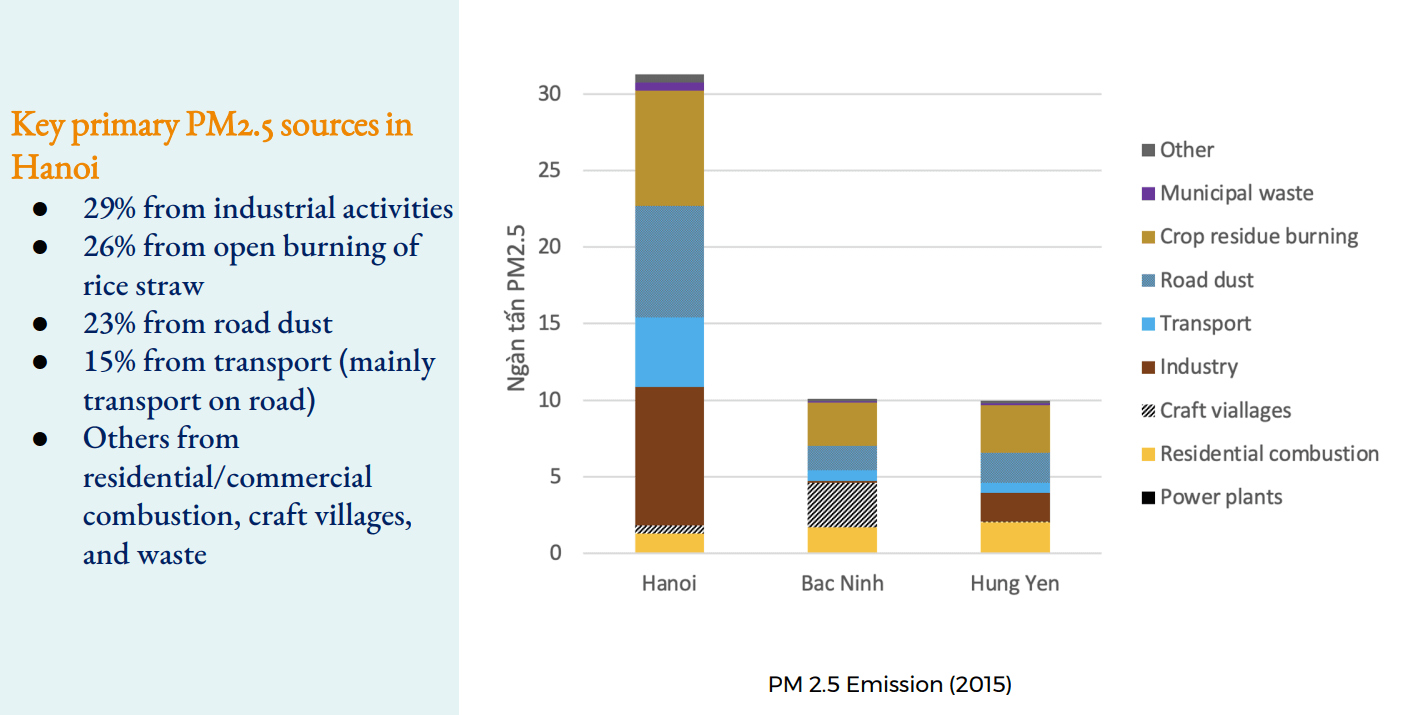
Sources of air pollution, according to the World Bank.
Agricultural burning, particularly in rural areas and during specific seasons, also contributes to air pollution in Vietnam. The practice of burning crop residue is common and releases large quantities of smoke and particulate matter into the air. The impact of this practice is not just limited to rural areas; the smoke often travels to urban areas, exacerbating air quality issues. The image above shows that even in Hanoi, nearly 26% of the air pollution is due to the burning of rice straw.
With Vietnam’s rapid urban development, construction activities have significantly contributed to air pollution. These activities release large amounts of dust and particulate matter into the air. The disruption of land surfaces, alongside the use of various construction materials, exacerbates air quality issues, especially in burgeoning urban centres like Ho Chi Minh City and Hanoi.
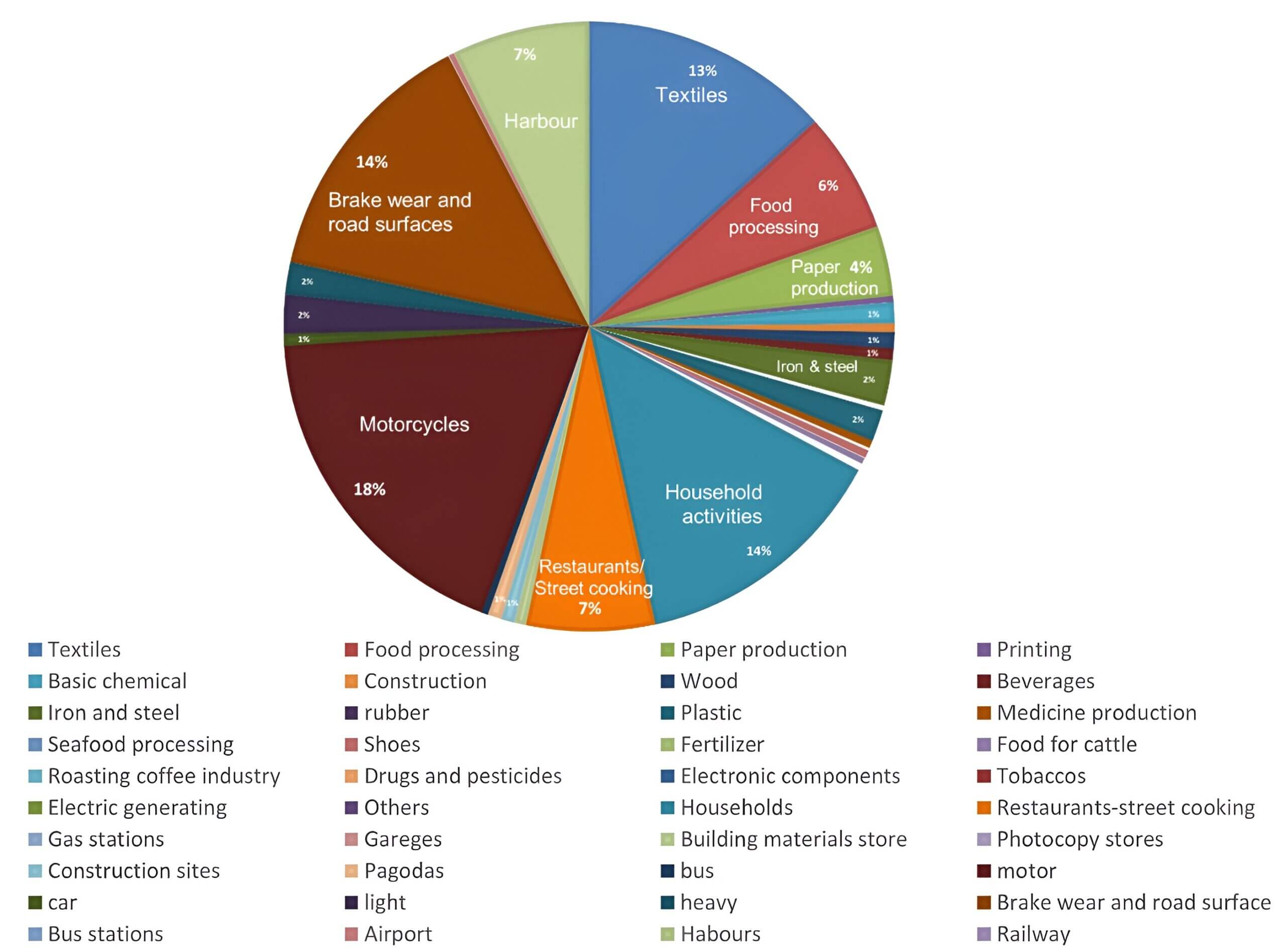
A detailed breakdown of PM2.5 emissions in Ho Chi Minh City.
According to a report by the Vietnam Environment Administration, construction sites are significant contributors to increased particulate matter (PM10 and PM2.5) in the air, which is harmful to human health. Mitigating measures like dust control and proper site management are crucial in managing this source of pollution.
Household pollution, primarily from burning solid fuels for cooking and heating, also poses a significant challenge in Vietnam, especially in rural areas. The World Health Organization has identified household air pollution as a major health risk, with emissions from solid fuels like wood, coal, and agricultural waste contributing to respiratory diseases.
In both urban and rural Vietnam, the open burning of waste is a prevalent but often overlooked source of air pollution. This practice releases a cocktail of harmful chemicals, including dioxins, furans, and particulate matter, into the atmosphere. A study by the Global Alliance for Incinerator Alternatives found that open waste burning, particularly in areas lacking proper waste management systems, contributes significantly to air pollution in Vietnam. Addressing this requires improved waste management strategies and public awareness campaigns.
Transboundary air pollution is another factor affecting air pollution in Vietnam. Air pollutants do not respect national borders, so Vietnam is often affected by pollution from neighbouring countries. During certain times of the year, smoke from agricultural burning in neighbouring countries can drift into Vietnam, significantly impacting air quality. Research by the ASEAN Specialised Meteorological Centre has documented instances of transboundary haze affecting air quality in Vietnam.
In conclusion, the causes of air pollution in Vietnam are diverse and interconnected, involving a mix of domestic activities and regional factors. Understanding these causes is crucial for developing effective strategies to tackle the air quality crisis in Vietnam. The next steps involve addressing these sources and enhancing regional cooperation to manage transboundary air pollution effectively.
Are All Cities in Vietnam Equally Polluted?
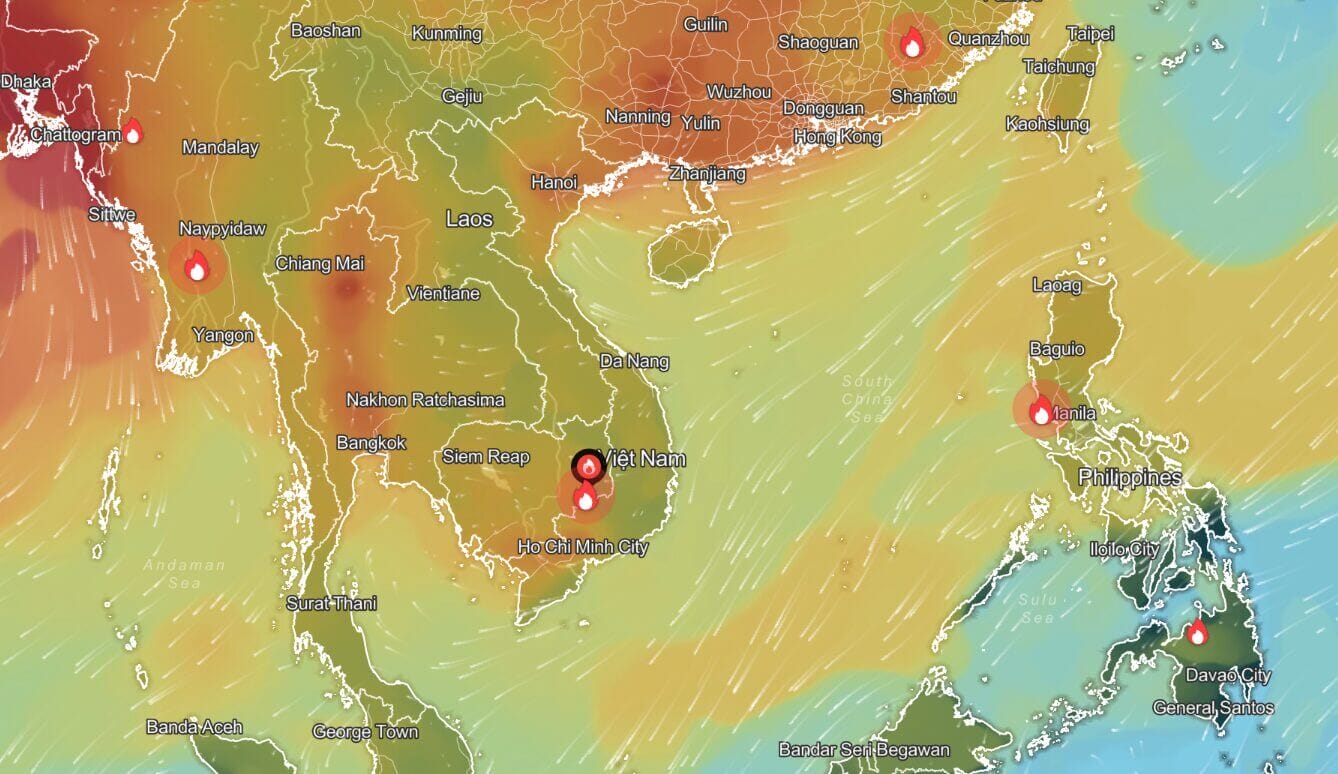
Geography plays a crucial role in how pollution is distributed and experienced across different cities in Vietnam. This section explores the variations in air pollution among Vietnamese cities, delving into how specific geographic and meteorological factors influence these differences. Not all cities in Vietnam bear the brunt of air pollution equally. Factors such as industrial density, traffic volume, and geographical location significantly influence the air quality in each city.
Hanoi and Ho Chi Minh City: Industrial and Traffic Congestions Hanoi and Ho Chi Minh City, Vietnam’s largest metropolises, consistently rank high on the list of the most polluted cities. The industrial activities combined with the high density of motorbikes and cars contribute significantly to the poor air quality in these cities. A study has revealed that emissions from vehicles and industrial activities are the leading causes of pollution in these urban areas.
Da Nang, Nha Trang and Hue: Relatively Cleaner Air In contrast, cities like Da Nang and Hue generally enjoy better air quality. Their lesser industrial activities, lower population density, and effective urban planning contribute to this. Additionally, their geographical positions, with proximity to the sea, aid in dispersing air pollutants more effectively.
Vietnam’s topography, characterized by its diverse landscape, ranging from the mountainous North to the flat Mekong Delta in the South, also plays a pivotal role in the dispersion and concentration of air pollutants. This geographical diversity leads to distinct regional air quality patterns, influenced by both human activities and natural factors.
In the northern mountainous regions, including areas around the capital city of Hanoi, the terrain contributes to the complex behaviour of air pollutants. These areas are often prone to temperature inversions, especially during the cooler months. Temperature inversions occur when a layer of warm air settles above cooler air near the ground, trapping pollutants and preventing them from dispersing.
This phenomenon is particularly noticeable in valleys and basins surrounded by mountains, where the stagnant air can accumulate pollutants, notably particulate matter. Studies have indicated that these inversions contribute to the significant spikes in air pollution levels during winter in cities like Hanoi, where geographic features compound the effects of urban emissions.
Moving southward, the landscape flattens into the expansive and fertile Mekong Delta region. This area’s topography, characterized by its vast network of rivers and low-lying plains, presents different challenges and advantages for air quality. The flat terrain allows for easier dispersion of air pollutants, which can help mitigate the intensity of pollution episodes to some extent. However, this region’s susceptibility to climate change and rising sea levels presents new challenges.
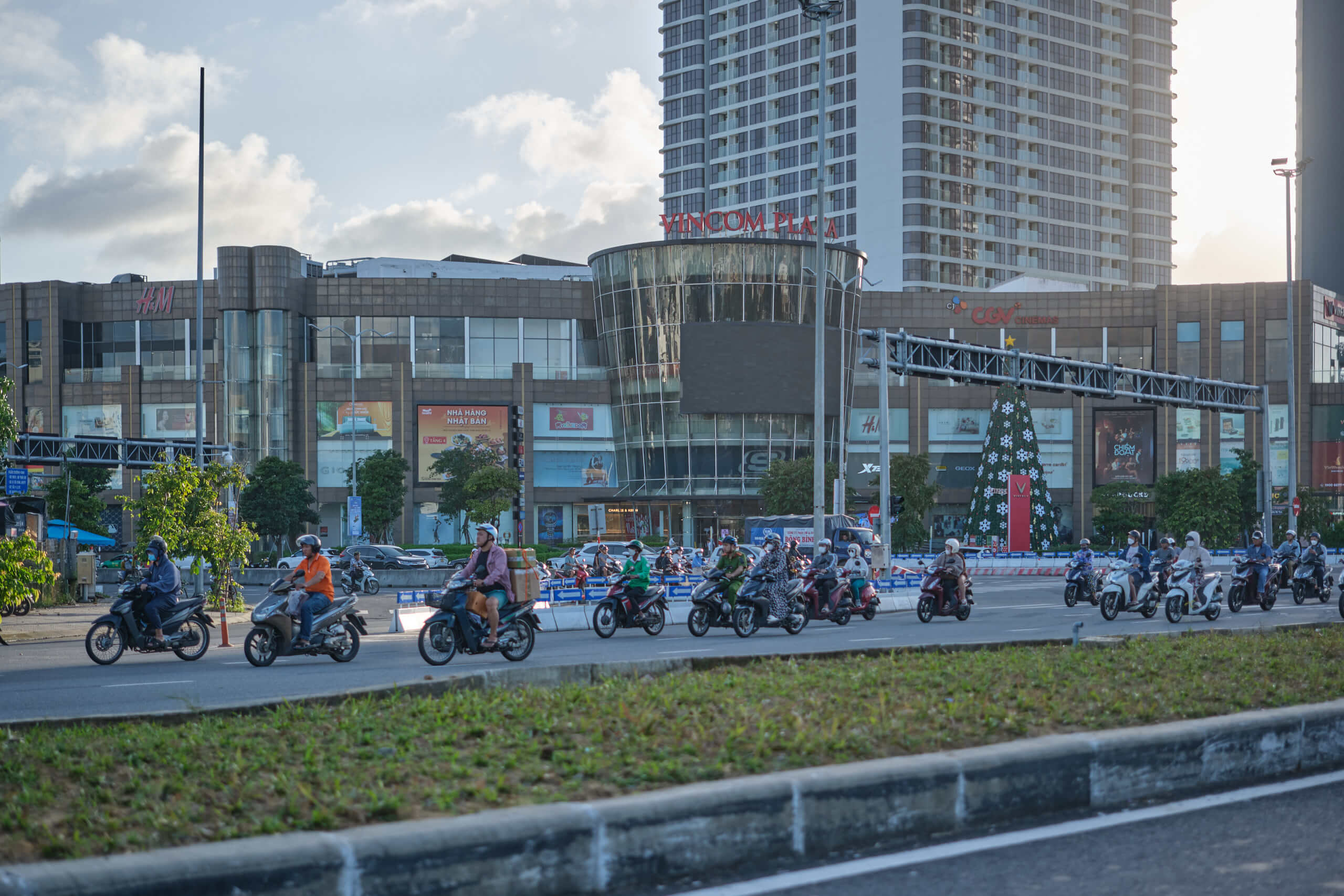
Motorbike traffic in Da Nang.
Rising sea levels and increased flooding can impact air quality indirectly by affecting land use patterns, urban development, and agricultural practices, all of which are integral to the region’s air pollution profile. The delta’s extensive water bodies can also influence local humidity levels and wind patterns, further impacting how pollutants are distributed in the air.
Furthermore, the Mekong Delta is a vital agricultural hub, and practices such as open burning of agricultural waste can significantly contribute to air pollution. The burning of crop residues, a common practice after harvest seasons, releases a substantial amount of smoke and particulate matter into the air. While the flat terrain aids in the dispersion of these pollutants, the sheer volume of agricultural burning can lead to localized air quality issues, particularly affecting rural and semi-urban areas within the Delta.
Understanding the interplay between Vietnam’s varied topography and air pollution is crucial for developing effective environmental management strategies. Recognizing that different regions face unique challenges due to their geographic characteristics, tailored approaches are needed to address the specific sources and behaviours of pollutants in each area.
For the northern mountainous regions, strategies might focus on reducing emissions during times of the year when temperature inversions are common. In contrast, the Mekong Delta might benefit from sustainable agricultural practices and improved waste management to reduce the impact of open burning on air quality.
Understanding the geographic and meteorological factors influencing air pollution is critical to developing effective mitigation strategies. For cities like Hanoi and Ho Chi Minh City, improving public transport, controlling industrial emissions, and implementing strict vehicle emission standards are crucial. In contrast, cities with better air quality should focus on sustainable urban planning to maintain cleaner air.
The air pollution disparity across Vietnamese cities clearly indicates how geography and weather patterns play a significant role in environmental health. Addressing these challenges requires a combination of targeted policies, technological innovations, and public awareness tailored to the unique needs of each region.
Seasonality of Air Pollution in Vietnam
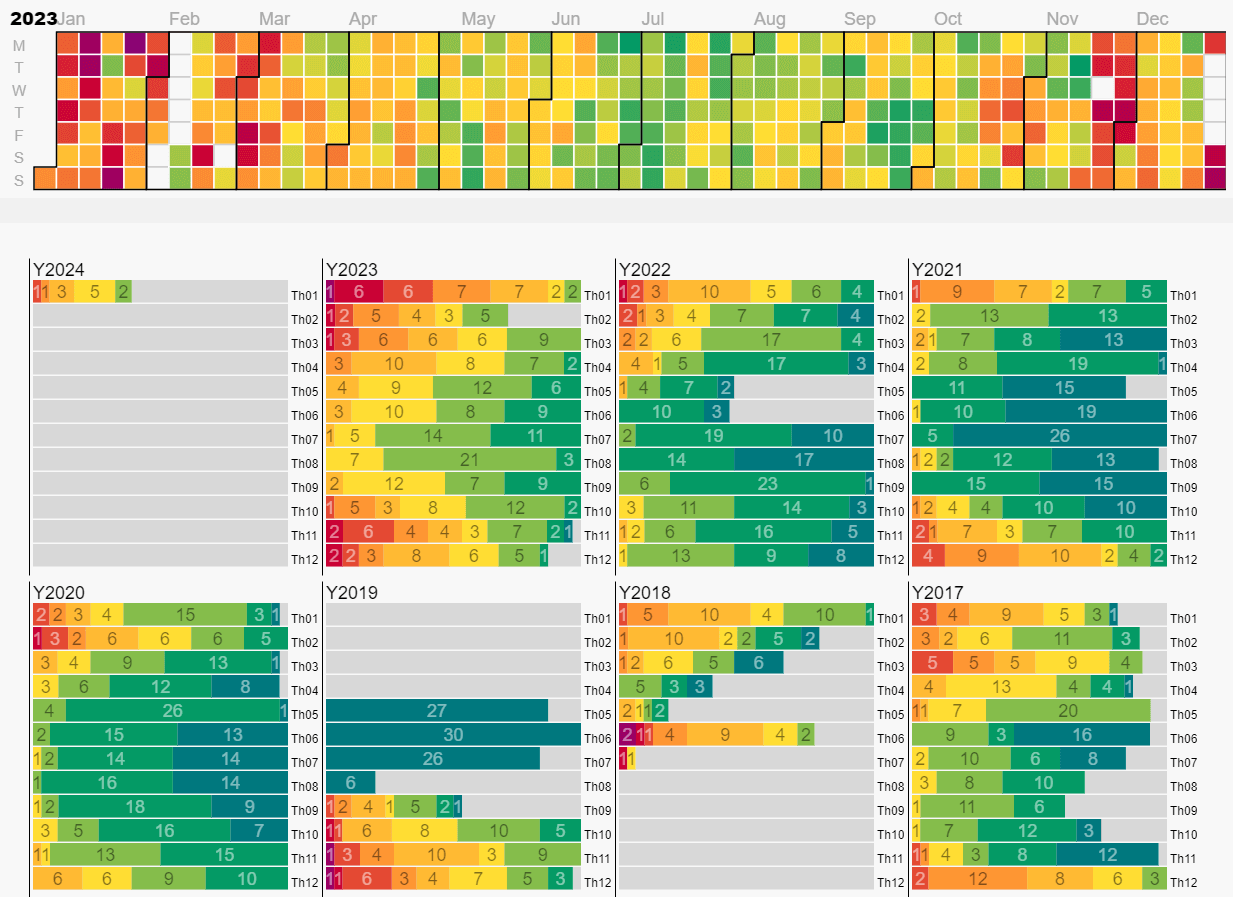
Annual air pollution in Hanoi. Graph from AQICN.
Now that we’ve discussed the geographical differences in air pollution in Vietnam, I want to examine whether seasonal weather patterns impact air quality. As you may have already guessed, air pollution in Vietnam exhibits a distinct seasonality influenced by meteorological, geographical, and human factors. The variation in air quality across different times of the year is not uniform across the country; it varies significantly from region to region, each influenced by its unique geographic and climatic characteristics.
In the northern regions, particularly in and around Hanoi, air pollution levels are significantly higher during winter, as shown in the table above. This seasonal spike can be attributed primarily to the meteorological phenomenon known as temperature inversion. Typically, the cooler air near the ground is trapped under a layer of warmer air above it in the colder months.
This inversion layer acts like a lid, trapping pollutants and preventing them from dispersing vertically, leading to higher concentrations of particulate matter and other pollutants. Additionally, the increased use of heating during these months, often through burning coal and other fossil fuels, contributes to worsening air quality. The calm and stagnant weather conditions, typical of winter in northern Vietnam, further exacerbate the situation by limiting the horizontal dispersion of pollutants.
In contrast, the summer months in northern Vietnam tend to see improved air quality. The warmer temperatures lead to a more convective atmosphere, facilitating the pollutants’ dispersion. Additionally, the summer months bring about the monsoon season, characterized by increased rainfall, which helps ” wash out” airborne pollutants, thereby improving air quality.
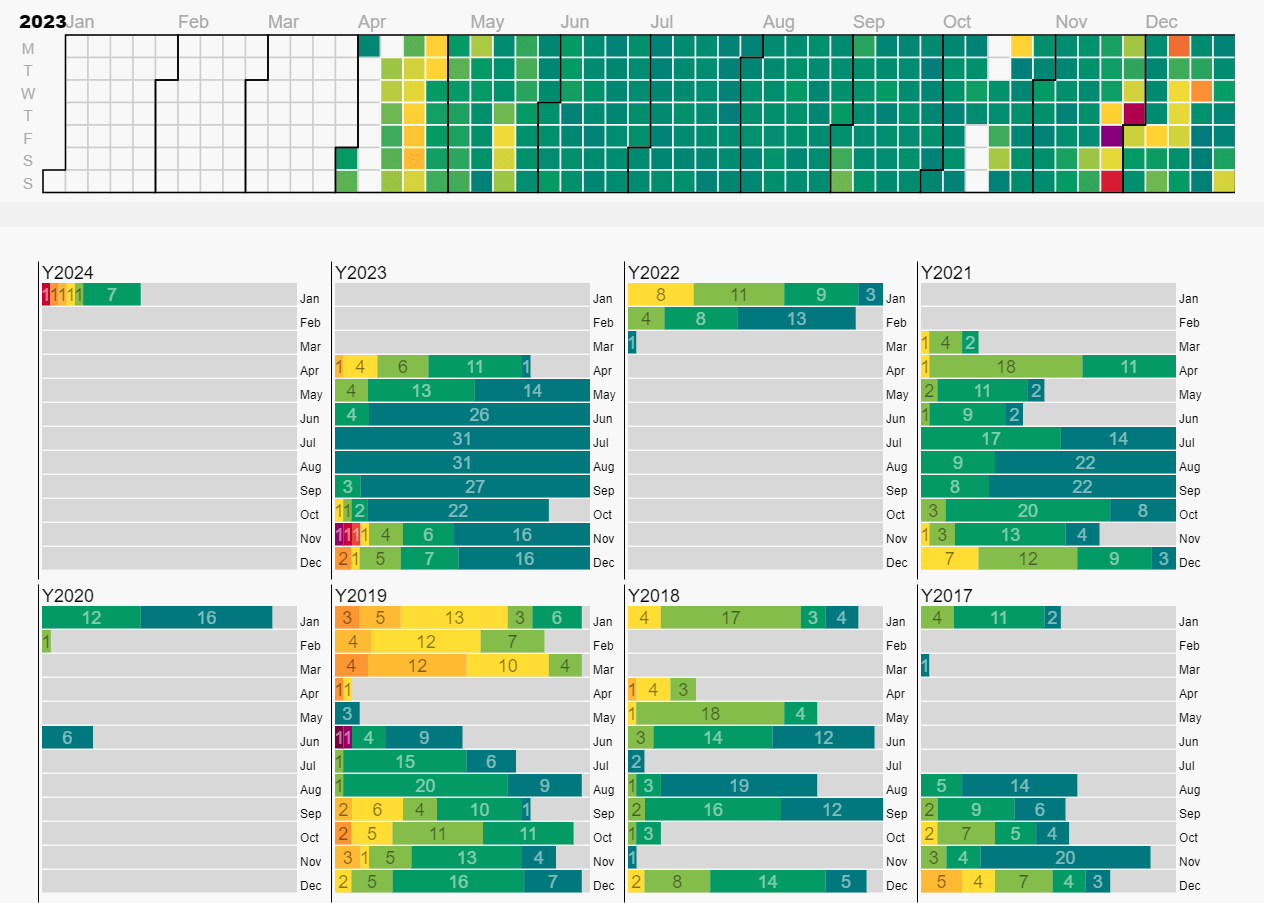
Annual air pollution in Da Nang. Unfortunately, the monitors appear to be missing large portions of data.
Moving towards central Vietnam, cities like Da Nang experience a different pattern of seasonal air pollution. Central Vietnam is subject to the effects of the northeast and southwest monsoons. The northeast monsoon, occurring from October to April, can bring cooler, drier air and sometimes pollution from industrial regions in northern Vietnam and neighbouring countries like China.
On the other hand, the southwest monsoon, prevailing from May to September, is typically warmer and wetter, which can help reduce pollution levels. However, it’s also important to note that central Vietnam’s topography, with its mountain ranges and coastal areas, plays a crucial role in how pollutants are distributed, with certain areas experiencing better air dispersion due to sea breezes.
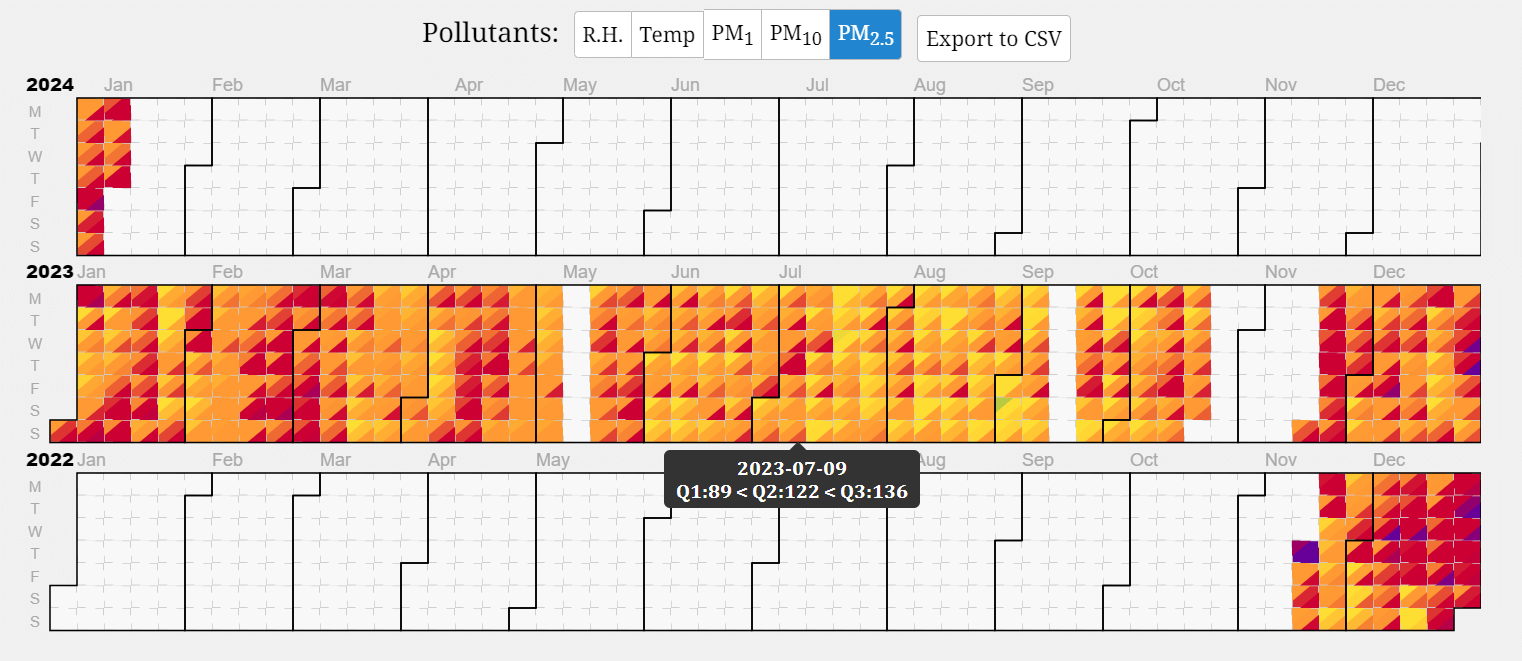
Annual air pollution in Ho Chi Minh.
In southern Vietnam, including Ho Chi Minh City, the dry season, which runs from December to April, is usually associated with higher levels of air pollution. During these months, reduced rainfall and increased sunshine lead to more stagnant air conditions, which can result in the accumulation of pollutants.
The dry season also coincides with increased agricultural burning in the Mekong Delta, contributing to regional air pollution. Conversely, the wet season, from May to November, sees a general improvement in air quality due to increased rainfall, which helps settle dust and other particulate matter.
Another critical factor contributing to the seasonality of air pollution in Vietnam is the practice of crop residue burning, especially in rural areas. Following the harvest seasons, the burning of crop residues is a common practice. This activity peaks twice a year, usually around April-May and October-November, coinciding with the post-harvest periods. The smoke and particulates released from this burning can significantly impact local air quality and, under certain meteorological conditions, can even affect the air quality of distant urban areas.
It’s also noteworthy that the seasonality of air pollution in Vietnam is not just a result of natural factors. Human activities, such as increased construction work and urban development projects, which often accelerate in the drier months, contribute to the air’s dust and particulate matter levels. The variation in industrial output and energy consumption patterns throughout the year also plays a role in the fluctuating levels of air pollution.
In summary, the seasonality of air pollution in Vietnam is a complex interplay of natural and human factors, varying significantly across different regions. The northern areas, particularly Hanoi, experience the worst air quality during winter, while the central and southern regions see a different pattern influenced by the monsoon seasons and topographical features. If you plan on travelling in Vietnam (which I highly recommend!), you might want to keep these seasonal changes in mind as they can greatly impact your experiences.
Health Effects of Air Pollution in Vietnam
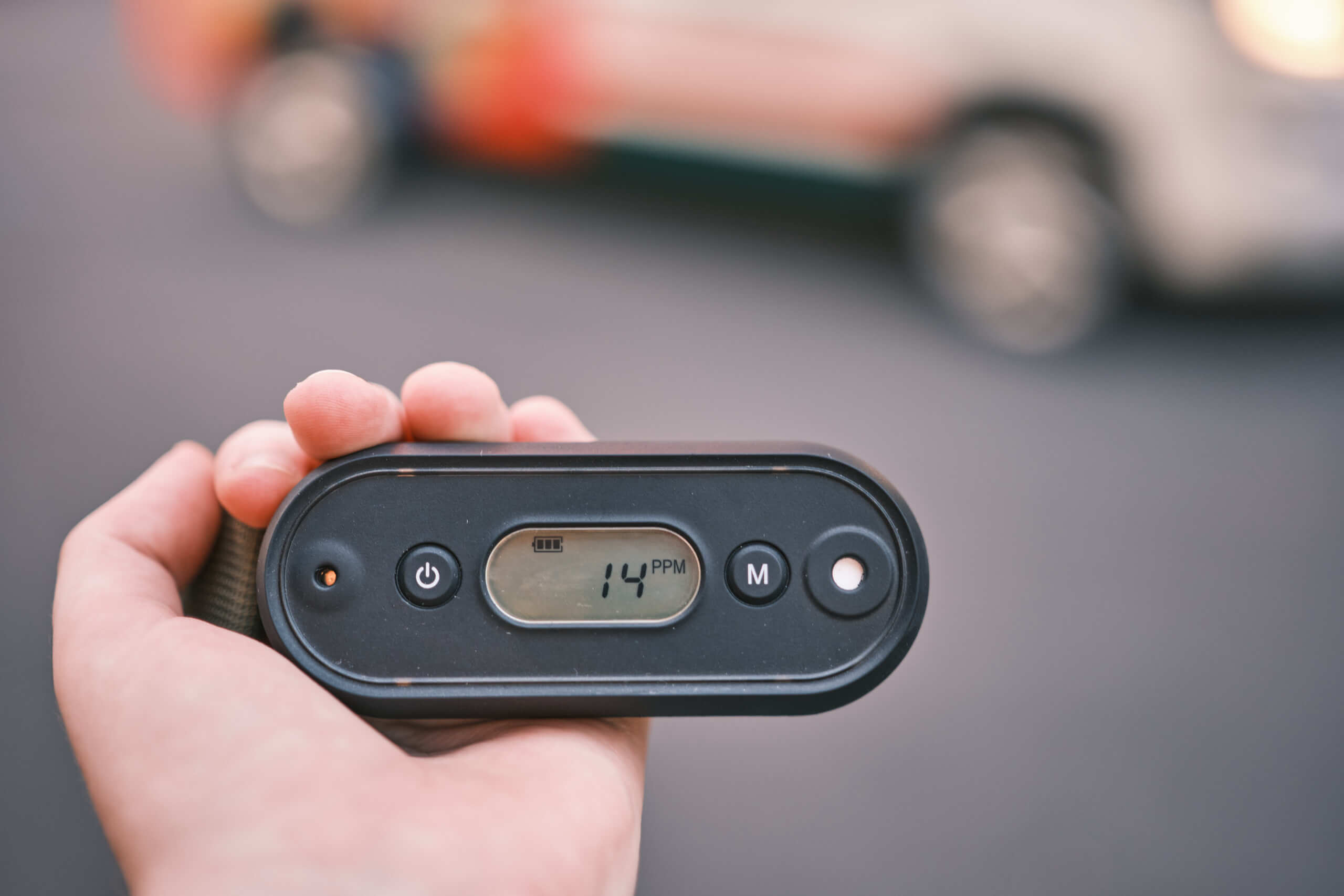
CO levels near a busy road in Ho Chi Minh. CO levels were monitored with the GZAIR SA103.
Air pollution is a significant public health concern in Vietnam, with far-reaching impacts that affect the health and well-being of its population. The general health impacts of air pollution are well-documented and include respiratory diseases, cardiovascular problems, and adverse effects on the immune system. However, in Vietnam, these impacts are particularly pronounced due to the country’s high levels of air pollutants.
Exposure to air pollutants, particularly fine particulate matter (PM2.5) and nitrogen dioxide (NO2), is linked to a range of serious health issues. These include respiratory conditions such as asthma and chronic obstructive pulmonary disease (COPD), as well as cardiovascular diseases like heart attacks and strokes. Long-term exposure can lead to reduced lung function, chronic bronchitis, and even lung cancer. Children, the elderly, and those with pre-existing health conditions are especially vulnerable to these effects.
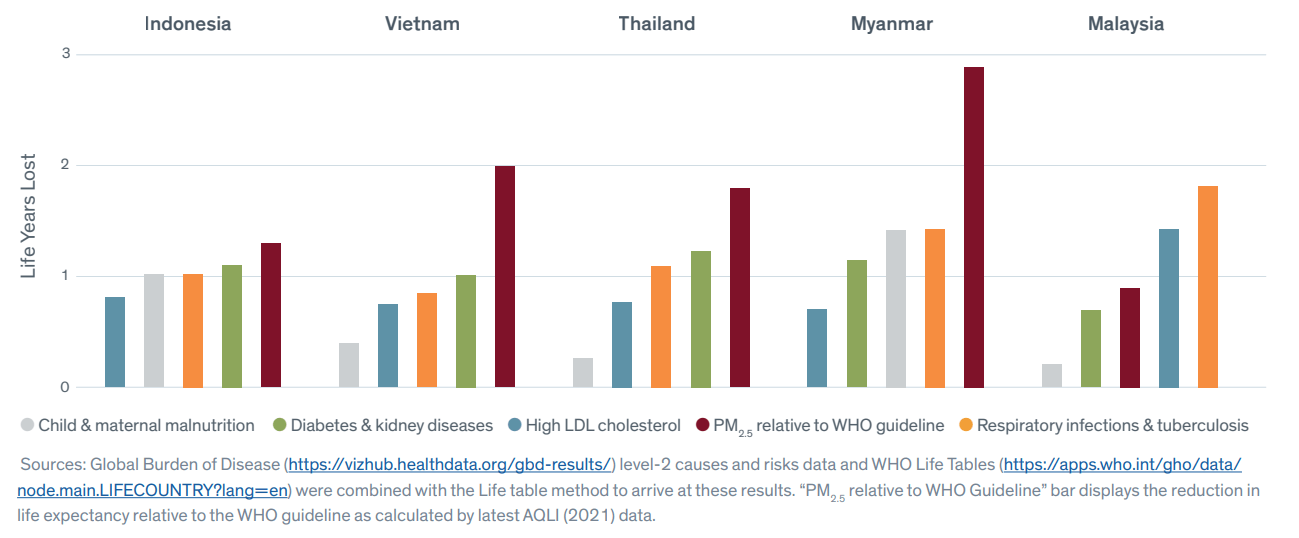
Life years lost due to illnesses in SEA.
However, I want to examine how air pollution impacts those in Vietnam specifically. In Vietnam, the health implications of air pollution are significant. A study by the Health Effects Institute (HEI) found that air pollution is a leading risk factor for premature death in Vietnam. In 2019, it was estimated that approximately 60,000 deaths in the country were attributable to ambient air pollution, highlighting the severity of the issue.
Furthermore, research indicates that air pollution in Vietnam has led to a decrease in life expectancy. A study by the Air Quality Life Index (AQLI) revealed that residents in Ho Chi Minh City could see their life expectancy reduced by more than 2.5 years if the 2019 levels of air pollution persist over time. This reduction is primarily due to increased risks of heart and lung diseases linked to prolonged exposure to high PM2.5 concentrations.
Overall, the average Vietnamese citizen stands to gain 2 years in life expectancy, if pollution was permanently reduced to the WHO guideline. This threat to life expectancy is significantly larger than other health threats in Vietnam such as diabetes (1 year) or respiratory infections and tuberculosis (0.9 years)
AQLI.

Life years gained if air pollution levels reach WHO standards.
Although I don’t like to talk about the impacts of air pollution from an economic perspective, I want to share this stat as it shows how significantly air pollution impacts the country. According to the World Bank, Vietnam loses about 3.2% of its GDP annually due to the effects of air pollution on health, including healthcare costs and labour productivity loss.
Particulate matter, especially PM2.5, is a major concern in Vietnamese cities. These fine particles can penetrate deep into the lungs and even enter the bloodstream, causing inflammation and exacerbating respiratory and cardiovascular conditions. There is a high incidence of respiratory diseases in urban areas like Hanoi and Ho Chi Minh City, where PM2.5 levels often exceed WHO guidelines. Hospitals in these cities report a consistent increase in patients with respiratory problems, especially during periods of high pollution.
Children in Vietnam are particularly affected by air pollution. Exposure to high levels of pollutants during critical development stages can lead to lifelong health issues, including reduced lung function and developmental delays. Studies have shown that children living in highly polluted areas of Vietnam have a higher prevalence of respiratory diseases like asthma and bronchitis compared to those in cleaner areas.
Air pollution’s impact on health also extends beyond the commonly known physical ailments and enters a realm that many may find surprising: mental health. The association between air pollution and various mental health conditions, including depression and increased suicide rates, is an emerging area of concern that is garnering increasing attention from the global health community.
Recent research indicates a significant correlation between high levels of air pollution and mental health disorders, particularly depression. Exposure to pollutants, especially fine particulate matter (PM2.5), has been linked to increased respiratory and brain inflammation. This inflammation can lead to changes in the brain’s chemistry and function, potentially exacerbating or even triggering depressive symptoms.
Studies have shown that people living in areas with high air pollution levels report higher rates of sadness, anxiety, and depression. These feelings can be attributed to the direct biological impacts of pollutants on brain chemistry and the stress and anxiety associated with living in a polluted environment.
This is all to say that air pollution, not only in Vietnam but worldwide, impacts our health and well-being in so many ways that it’s fair to say it’s life-changing. Whether we know it or not, air pollution impacts everything from our mental health and well-being to our physical health. These issues become exacerbated in Vietnam, where air pollution often exceeds the WHO guidelines many times over.
The History and Future of Air Pollution in Vietnam
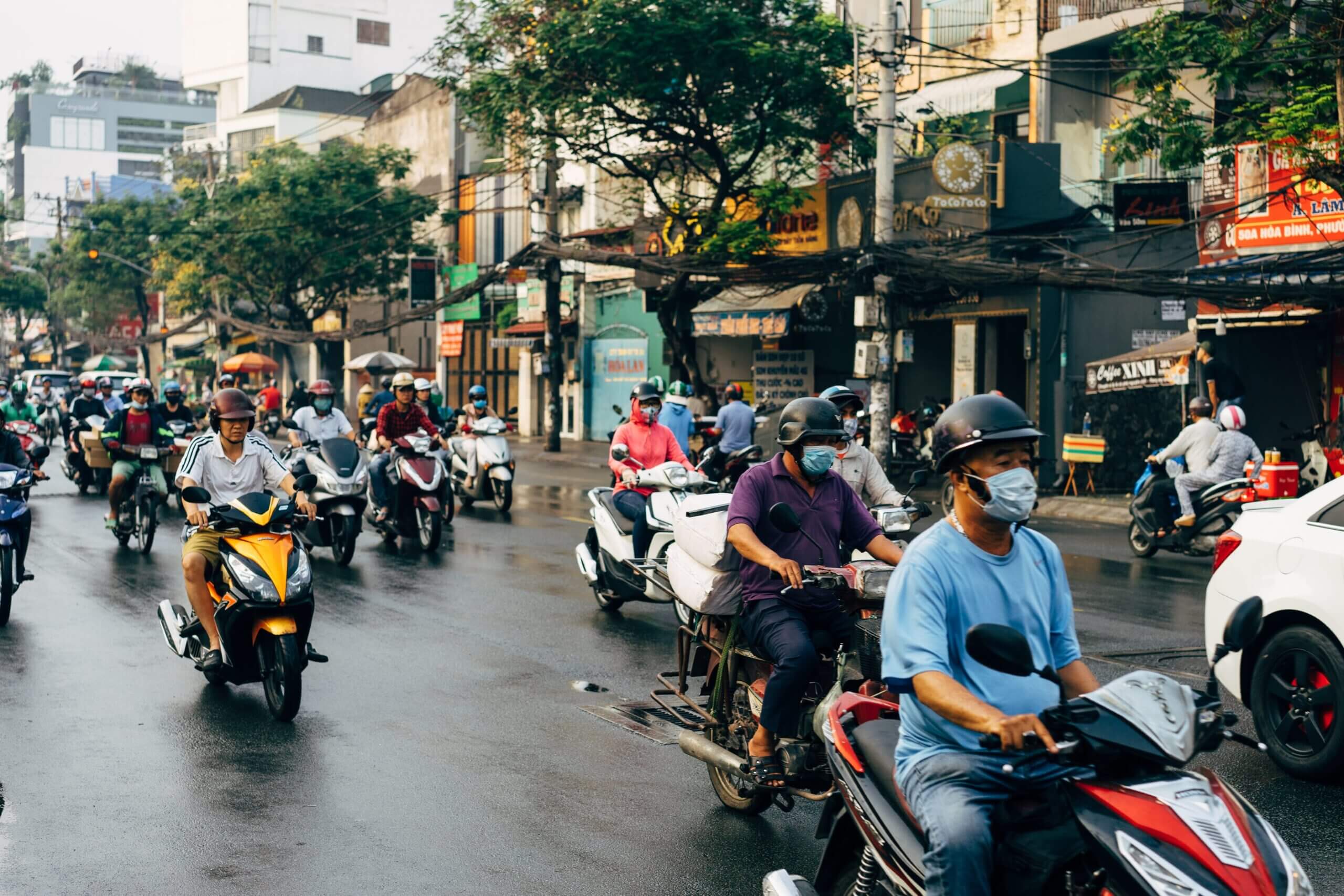
Vietnam’s air quality over the past few decades presents a narrative of contrasts shaped by the dual forces of rapid economic development and environmental policy responses. The trajectory of air pollution in Vietnam has been influenced by a myriad of factors ranging from industrial growth and urban expansion to evolving environmental regulations and global economic trends.
In the years following Vietnam’s economic liberalization, the country experienced a significant increase in industrial activities, urbanization, and vehicular traffic. These developments, while boosting the economy, also increased air pollutant emissions. Cities like Hanoi and Ho Chi Minh City, in particular, have borne the brunt of this pollution.
The rise in industrial factories, burgeoning fleets of motorbikes and cars, and sprawling construction projects have collectively degraded air quality. Historical data and studies over the years have consistently shown elevated levels of particulate matter (PM2.5), nitrogen dioxide (NO2), and other harmful pollutants in these urban centres.
However, the picture is not uniformly bleak. There have been periods where air quality improvements were observed, often linked to specific interventions or broader economic shifts. For example, during the COVID-19 pandemic, temporary improvements in air quality were recorded in several Vietnamese cities, attributed to lockdowns and reduced economic activities. Such instances provide a glimpse into the potential for air quality improvement under reduced emissions scenarios.
Addressing the escalating air pollution problem, the Vietnamese government has rolled out a series of policies and initiatives. These include introducing stricter vehicle emission standards, efforts to shift towards cleaner energy sources, and investments in public transportation infrastructure. The government has also recognized the importance of robust air quality monitoring and public reporting to increase transparency and drive policy action.
Despite these efforts, the effectiveness of these policies has faced challenges. One critical issue is enforcement; ensuring compliance with environmental regulations remains daunting in the face of rapid urban and industrial expansion. Additionally, there is a need for a more integrated approach that considers the complexities of economic development, urban planning, and environmental sustainability.
Looking ahead, Vietnam’s air quality trajectory will likely hinge on a balance between economic growth and environmental stewardship. The country’s future urbanization and industrialization patterns, coupled with the vigour of policy implementation and global environmental trends, will shape this balance. There is a sense of cautious optimism driven by increased environmental awareness among the public and policymakers, growing international cooperation, and technological advancements in pollution control. Initiatives like the promotion of electric vehicles and renewable energy adoption hold promise for cleaner air.
In conclusion, Vietnam’s journey towards cleaner air is an ongoing process, marked by challenges but also opportunities for positive change. The coming years will be pivotal in determining whether the country can steer its rapid economic growth towards an environmentally sustainable path. Achieving significant air quality improvements will require stringent and well-enforced policies and a collective commitment to sustainable development practices.
How You Can Protect Yourself From Air Pollution in Vietnam

Knowing the causes and dangers of air pollution is vital, but the knowledge is meaningless if you don’t also know how to protect yourself. While this article so far might have seemed bleak, it’s important always to remember that there are steps you can take to protect yourself. As someone who’s currently living in Vietnam myself, these are the steps I take to safeguard my health.
Regularly Check the AQI
Regularly checking the Air Quality Index (AQI) is a crucial practice for anyone concerned about air pollution. AQI serves as a standardized tool that quantifies and communicates air pollution levels. It incorporates data on various pollutants, including PM2.5 (fine particulate matter), PM10 (coarse particulate matter), ozone (O3), nitrogen dioxide (NO2), sulfur dioxide (SO2), and carbon monoxide (CO). These pollutants have different sources and health impacts, making the AQI a comprehensive indicator of air quality.
The AQI scale typically ranges from 0 to 500, with higher values indicating worse air quality. Each AQI level is associated with specific health advisories, making it easier for individuals to understand the potential health risks. For instance, an AQI value between 0-50 is considered ‘Good’, posing little or no risk, while a value above 300 is categorized as ‘Hazardous’, with serious health effects for the entire population.
Utilizing AQI data allows individuals to tailor their daily activities to minimize exposure to pollution. This is particularly important for sensitive groups, such as children, the elderly, and individuals with pre-existing respiratory or cardiovascular conditions. For example, on days with high AQI levels, outdoor activities like jogging or cycling might be better rescheduled or replaced with indoor exercises.
Accessing real-time AQI data has become more convenient than ever, thanks to various websites and mobile applications. These platforms provide timely updates, often with hourly data, enabling users to make informed decisions about their exposure to outdoor air. Some popular AQI monitoring apps and websites include the AirVisual app and AQICN website… At least, these are my favourites!
Wear a Mask (Respirator)
Wearing a well-fitted mask, especially in areas with high levels of air pollution, is a critical personal protective measure. Masks (well, actually, respirators ) such as N95 respirators are particularly effective as they are designed to filter out most airborne particles, including fine particulate matter (PM2.5). These respirators provide a close facial fit and efficient filtration of airborne particles.
The effectiveness of a mask largely depends on its fit. A well-fitted N95 mask seals tightly around the nose and mouth, leaving little room for air leakage, which is crucial for ensuring maximum protection. In contrast, cloth and surgical masks, although useful for preventing the spread of diseases, are ineffective against fine air pollutants due to their loose fit and lack of specialized filtering materials.
Even among respirator-type masks, the effectiveness can vary. Earloop masks like KN95s and KF94s, while offering better protection than cloth masks, may not provide as snug a fit as N95 respirators, which typically have headbands that create a tighter seal. This difference can affect the level of protection against air pollution.
It’s important to check the condition of your mask regularly. Over time, the filtering capability of the mask can diminish, especially if it gets physically damaged or soiled. Follow the manufacturer’s guidelines for replacement to ensure that you are always adequately protected.
Stay Indoors
Staying indoors during periods of high pollution is an effective way to minimize exposure to harmful air pollutants. This strategy is particularly important for vulnerable groups, such as children, the elderly, and individuals with pre-existing respiratory or cardiovascular conditions, who are more susceptible to the adverse effects of poor air quality.
When air pollution levels are high, pollutants like PM2.5, ozone, and nitrogen dioxide can reach harmful concentrations outdoors. By staying inside, you can significantly reduce your exposure to these pollutants. However, it’s important to ensure that the indoor air remains clean. Keeping windows and doors closed prevents outdoor pollutants from entering, which is especially critical during peak pollution times. Additionally, using indoor air purifiers with HEPA filters can help to reduce indoor pollution levels further.
For those who need to go outside, limiting the time spent outdoors and avoiding strenuous outdoor activities can help reduce the risk of adverse health effects. If you must go outside, try to do so when pollution levels are lower, such as early morning or late evening.
Use an Air Quality Monitor
For people living in Vietnam, an air quality monitor can be a crucial tool for managing indoor air quality. When outdoor pollution levels are high, these pollutants can infiltrate homes, affecting the indoor environment. An air quality monitor helps in several ways:
- Identifying Outdoor Pollution Infiltration: It can detect spikes in indoor pollutant levels that may result from outdoor air, especially during high pollution days. This information is vital for taking timely actions, like closing windows or activating air purifiers.
- Guiding Ventilation Decisions: Knowing when outdoor air quality is poor helps make informed decisions about ventilation. If the monitor indicates high levels of pollutants indoors correlating with outdoor pollution spikes, it suggests reducing or timing the ventilation when outdoor air quality improves.
- Optimizing Air Purifier Use: Air quality monitors can guide the effective use of air purifiers, especially during times when outdoor air quality is poor. By monitoring indoor air quality levels, you can run air purifiers more efficiently, focusing on periods when indoor pollution levels rise due to poor outdoor air quality.
An air quality monitor helps bridge the gap between outdoor and indoor air quality, providing valuable data to safeguard the indoor environment against external pollution, which is particularly relevant in areas with poor outdoor air quality, like many urban centres in Vietnam.
It’s also worth noting that due to the lack of government monitors in Vietnam, you might also want to consider an outdoor air quality monitor such as the AirGradient Open Air. These monitors can provide invaluable insights into outdoor air quality, especially in the absence of official monitors. However, even with official monitors, I find a personal outdoor air quality monitor can be helpful as air pollution can be very localised.
Use an Air Purifier
Where outdoor air pollution is a significant concern, securing your home and using air purifiers are vital steps in creating a healthier indoor environment. Sealing your home effectively prevents the entry of outdoor pollutants such as PM2.5 particles, which are prevalent in many densely populated cities. This involves checking for and sealing gaps around windows, doors, and any other openings.
Once your home is properly sealed, using air purifiers becomes an essential measure. Air purifiers equipped with HEPA filters are particularly effective in trapping fine particles and other common pollutants. They are especially beneficial in bedrooms and living areas, where individuals spend a considerable amount of time. By continuously filtering the indoor air, these purifiers can significantly reduce your exposure to harmful pollutants that may have entered from the outside or those generated indoors, thus helping to maintain clean and healthy air quality in your home.
Avoid Intense Activities (Exercise)
Avoiding outdoor exercise during times of high pollution in Vietnam is a crucial health consideration. When air quality is poor, pollutants like PM2.5 can reach harmful breathing levels, especially during physical exertion. Exercise naturally increases your breathing rate and depth, leading to the inhalation of greater quantities of these pollutants. This can exacerbate respiratory issues and even affect cardiovascular health.
To minimize health risks, it’s recommended to adjust exercise routines. Checking the AQI can inform you about the best times to exercise outdoors. During periods of high pollution, opting for indoor physical activities, such as gym workouts, yoga, or indoor cycling, is safer. Indoor environments, particularly those with air purifiers, offer cleaner air, making them a safer option for maintaining physical fitness without the risk of inhaling harmful air pollutants.
Conclusion
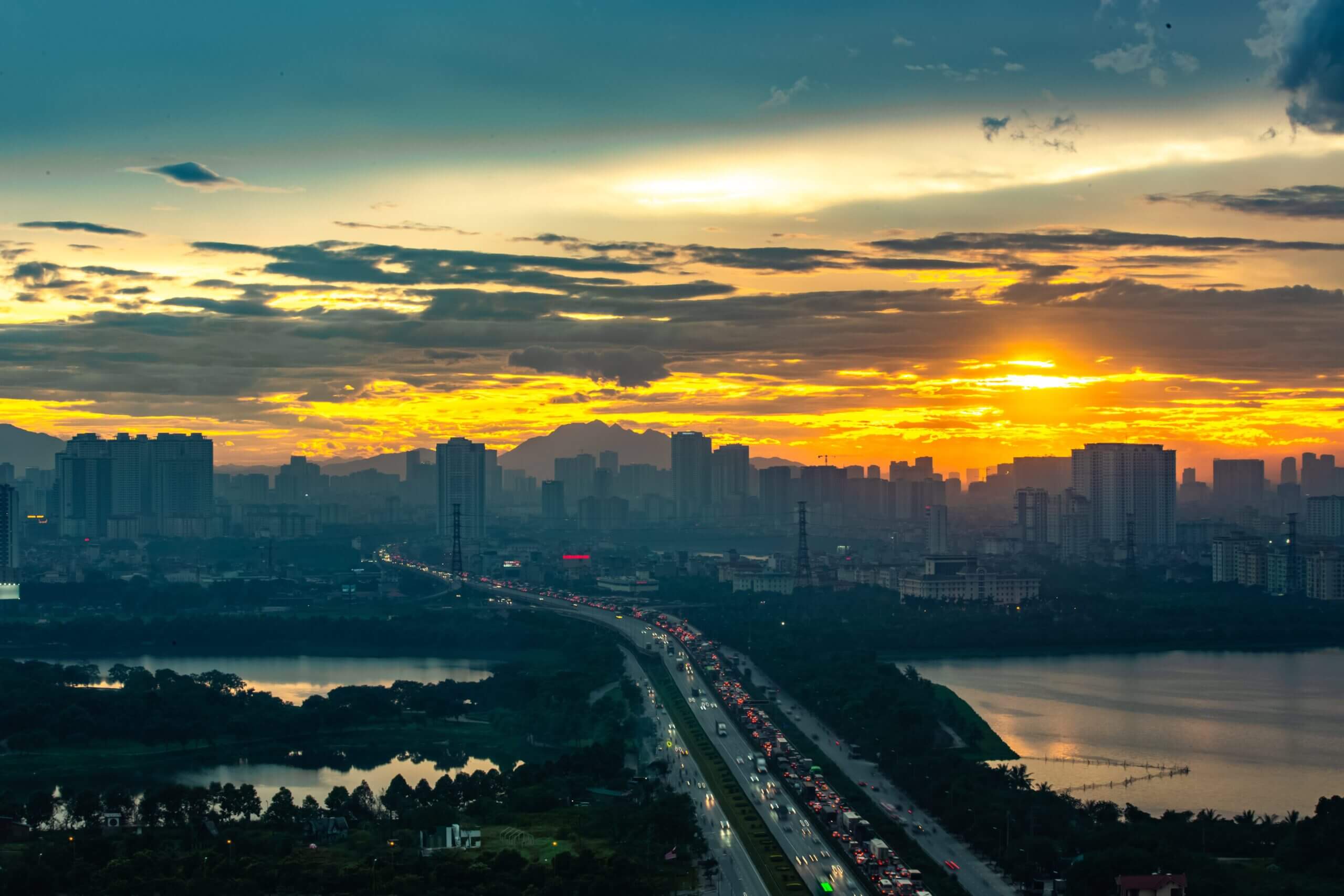
Vietnam’s struggle with air pollution is a reality that intertwines with its vibrant culture and stunning landscapes. During my time in cities like Ho Chi Minh, Hanoi, Nha Trang, and Da Nang, I’ve experienced the pervasive haze of pollution firsthand. This isn’t just a fleeting inconvenience; it’s a persistent issue that affects everyday life, particularly in urban areas like Ho Chi Minh City, where I spent six months last year.
The stark contrast between Vietnam’s natural beauty and the smog that often blankets its cities is a jarring reminder of the environmental challenges it faces. The World Air Quality Report’s alarming statistics, with Hanoi and Ho Chi Minh City frequently ranking among the world’s most polluted cities, illustrate a broader environmental issue that affects millions. Living in these conditions isn’t just about dealing with reduced visibility or discomfort; it’s about confronting a public health crisis that claims thousands of lives each year.
Despite these challenges, my experiences in Vietnam have taught me the importance of resilience and proactive measures in facing air pollution. Regular AQI checks have become a routine part of my day, guiding decisions on outdoor activities. I’ve learned the effectiveness of wearing N95 masks, not just as a health necessity but as a tool for empowerment against pollution. Staying indoors on days of high pollution and using air purifiers have also been crucial strategies for maintaining health and well-being.
Yet, what stands out most in my experience is the contrast in public discourse about air pollution. In places like Seoul and Thailand, where I’ve also lived, air quality is a regular topic of conversation, reflecting a heightened awareness and concern. However, in Vietnam, despite the severity of air pollution, the issue often seems sidelined in everyday discussions. This observation underscores a need for greater public awareness and dialogue about air pollution, its health impacts, and protective measures.
To those considering visiting or moving to Vietnam, I say: don’t be deterred by the air pollution. Vietnam is a country of immense beauty and cultural richness. However, it’s essential to be informed and prepared. Understanding the air quality trends, equipping yourself with protective measures, and staying informed about local environmental conditions are key. With this knowledge, you can navigate the challenges of air pollution and fully embrace the vibrant life that Vietnam offers.
Air Pollution in Vietnam FAQ
What are the main sources of air pollution in Vietnam?
The primary sources include industrial emissions, vehicular pollution, agricultural burning, construction activities, household pollution, waste burning, and transboundary air pollution.
Which cities in Vietnam have the highest levels of air pollution?
Hanoi and Ho Chi Minh City are frequently ranked among the most polluted cities in Vietnam, often exceeding WHO air quality guidelines.
How does air pollution in Vietnam affect health?
Air pollution contributes to respiratory diseases, cardiovascular problems, reduced lung function, and even mental health issues like depression.
What can individuals do to protect themselves from air pollution in Vietnam?
Regularly checking the AQI, wearing N95 masks, staying indoors during high pollution, using air purifiers, and avoiding outdoor exercise during peak pollution times are effective measures.
Is air pollution in Vietnam getting better or worse?
The trend is complex, influenced by rapid urbanization and industrialization along with evolving environmental policies; recent initiatives offer hope for improvement, but challenges in policy implementation persist.
Have Questions or Comments?
Join the discussion on the BreatheSafeAir Community Forum. Ask any questions you have about air quality or adjacent topics and get quick answers!
